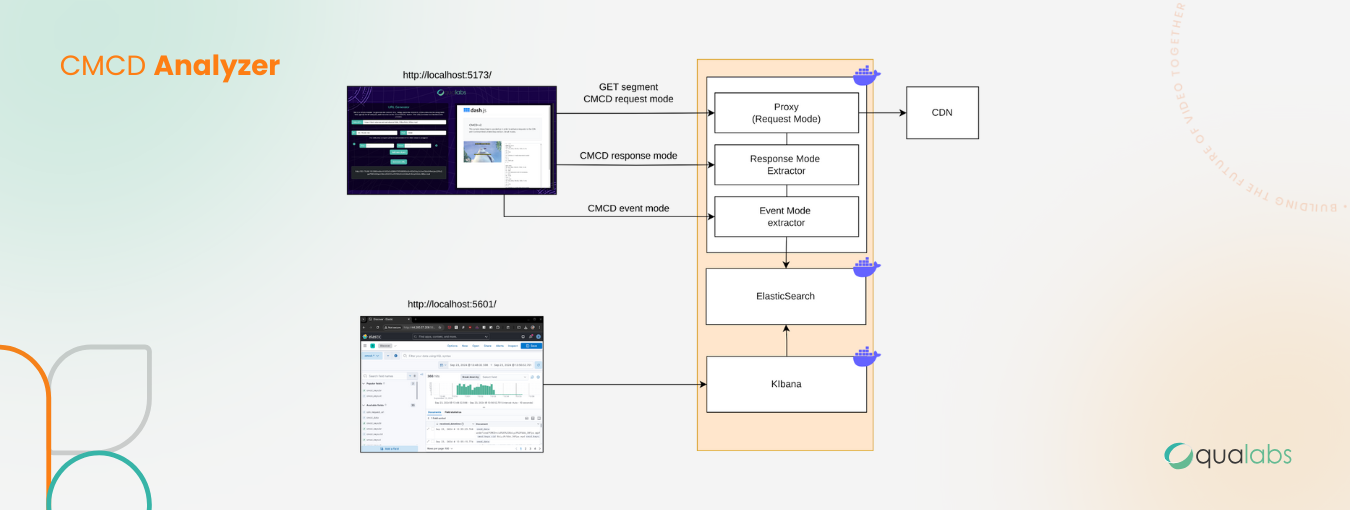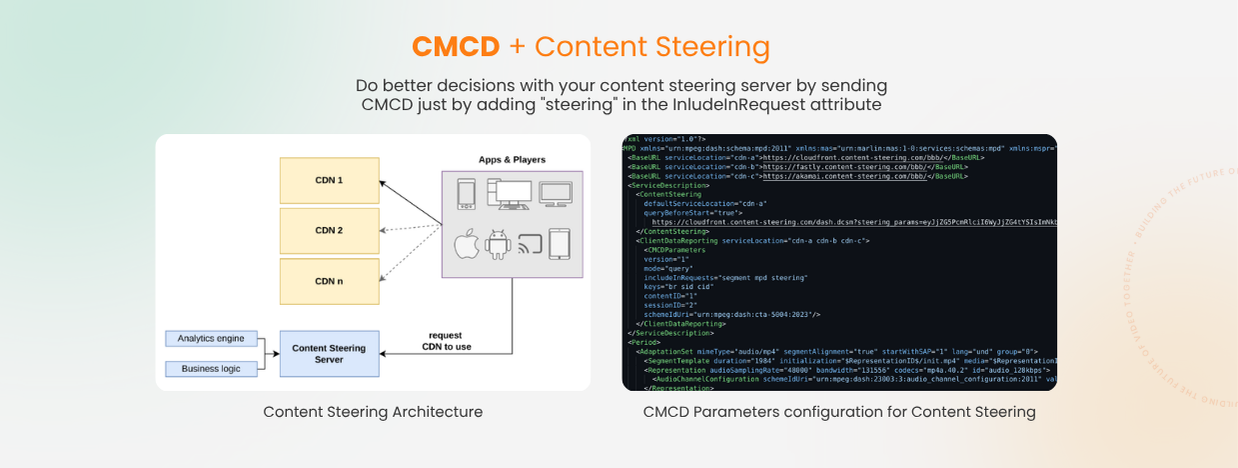Table of Contents
- What is CMCD and why It matters
- Limitations of CMCD v1
- Introducing CMCD v2: Modes and Metrics
- Qualabs’ Role in Enabling CMCD v2
- Use Cases: Why CMCD v2 is a Game-Changer
- Looking Ahead: A New Standard for Streaming Analytics
What is CMCD and why it matters
Common Media Client Data (CMCD) is a technical standard that enables video clients to send structured playback data—like buffer levels, session IDs, and bitrates—to content delivery networks (CDNs) or analytics systems. This allows streaming platforms to better understand client behavior and fine-tune content delivery based on real-time playback conditions.
Before CMCD, this kind of data was either missing, custom, or inconsistently implemented, making reliable analytics and optimization across players and CDNs nearly impossible. CMCD v1 addressed this by sending data as HTTP headers or URL query parameters during segment requests.
Limitations of CMCD v1
As foundational as CMCD v1 was, it had serious limitations.
It relied solely on the Request Mode, where client data was sent with every media segment request. This meant analytics teams could only analyze events retroactively and with limited context.
For example:
- No way to report when an error or buffer event occurred
- No access to response-level metrics like time to first/last byte
- Inflexible—one data stream, tied to media requests
This approach lacked the granularity required for advanced telemetry, such as personalized content steering or accurate QoE scoring.
Introducing CMCD v2: Modes and Metrics
CMCD v2 isn’t just a small update—it’s a foundational leap forward in client-side telemetry for video streaming. Where CMCD v1 offered a useful but limited view of playback via static data in segment requests, v2 unlocks three transmission modes, more expressive metrics, and flexibility designed for real-time streaming at scale.
CMCD v1 vs CMCD v2 – What’s New?
| Feature | CMCD v1 | CMCD v2 |
|---|---|---|
| Transmission Mode | Request only | Request, Response, and Event modes |
| Data Timing | Sent with media requests only | Sent on request, on response, or based on player events |
| Temporal Context | No timestamps | Full timestamps (ts) on events |
| Network Feedback | Not included | Includes response code (rc), TTFB, TTLB |
| Event Reporting | Not supported | Supports named events (e=start, e=buffer, etc.) |
| Flexibility | Static, limited to requests | Dynamic, multi-angle telemetry |
Three Modes: New dimensions of Insight

1. Request Mode
This is the same as in v1—sending playback data with each media request via query string or header. It's backward compatible and useful for quick integration.
2. Response Mode
This new mode empowers the client to report back what happened after receiving content.
This includes: rc url ttfb ttlb
Now, operators can correlate playback issues with network behavior, catching anomalies like slow edge response or mid-stream CDN failures.
3. Event Mode
This is where CMCD v2 shines. The client can emit data tied to specific events like playback start, stall, or error. Each event includes: e ts
This enables true event-based diagnostics. You’re no longer inferring QoE from static numbers—you’re seeing the user's experience as it unfolds, frame by frame.
The Real Power of CMCD v2
CMCD v2 turns data into action. With its new capabilities, you can:
- Trace session history in high fidelity, including every stall, retry, and network shift.
- Detect subtle CDN performance issues by analyzing response codes and latency metrics in real time.
- Build custom logic on the player side—such as switching CDNs or bitrates—based on live event triggers.
- Capture user experience metrics across devices and players in a standard, interoperable way.
As described in the CMCD v2 Overview:
In short: CMCD v2 is not just about collecting data. It’s about giving teams the visibility and control they need to build smarter, faster, and more resilient video platforms.

Qualabs’ Role in enabling CMCD v2
At Qualabs, we recognized the importance of CMCD v2 early, and took action to make its adoption easier across the industry.
CMCD Analyzer
We developed the CMCD Analyzer, an open-source tool that intercepts CMCD data from VOD or live content (HLS or DASH) and pushes it to Elasticsearch for analysis. Visualizations are powered via Kibana or a web-based UI, offering developers full visibility into playback behavior.
It’s built with Docker Compose, so setup takes just 3 minutes—making this tool ideal for developers looking to validate, explore, or debug their CMCD streams.
From our own documentation:

Dash.js CMCDParameters
Qualabs also contributed improvements to dash.js, a widely used MPEG-DASH player. We added support for CMCDParameters, enabling developers to configure CMCD values dynamically via the MPD.
This is crucial for use cases like:
- Changing content IDs during ad insertion periods
- Enabling CMCD for some streams and disabling for others
- Routing traffic to preferred CDNs on a per-period basis
These contributions empower platforms to adapt CMCD usage in real time, depending on session conditions.

Use Cases: Why CMCD v2 Is a Game-Changer
CMCD v2 turns passive analytics into actionable intelligence.
Let’s say your player logs a stall event. With CMCD v2’s Event Mode, you know exactly when it happened (ts) and under what conditions (br, bl, rc, etc.). This precision lets your teams:
- Pinpoint root causes faster
- Tune ABR algorithms more effectively
- Trigger CDN rerouting dynamically
Meanwhile, tools like the CMCD Analyzer give you a full playback view, from first byte to final segment, all indexed and searchable.
“You’re not guessing anymore—you’re watching real playback flow through your stack, enriched with structured metadata.”
This is especially useful in high-scale environments where AB testing, network variability, and multi-CDN deployments create complex scenarios.
Looking Ahead: A new standard for Streaming Analytics
With CMCD v2, we’re moving toward a more intelligent, responsive, and transparent era of streaming video.
The ability to combine client-driven metrics, event logs, and response diagnostics creates a powerful foundation for:
- Enhanced user experiences
- Real-time operational insights
- Smarter infrastructure decisions
At Qualabs, we’re committed to not only adopting these standards—but enabling others to do so through open-source tools, player integrations, and community collaboration.
If you’re ready to evolve your analytics stack, CMCD v2 is your starting point.

.png)
.png)
.png)
